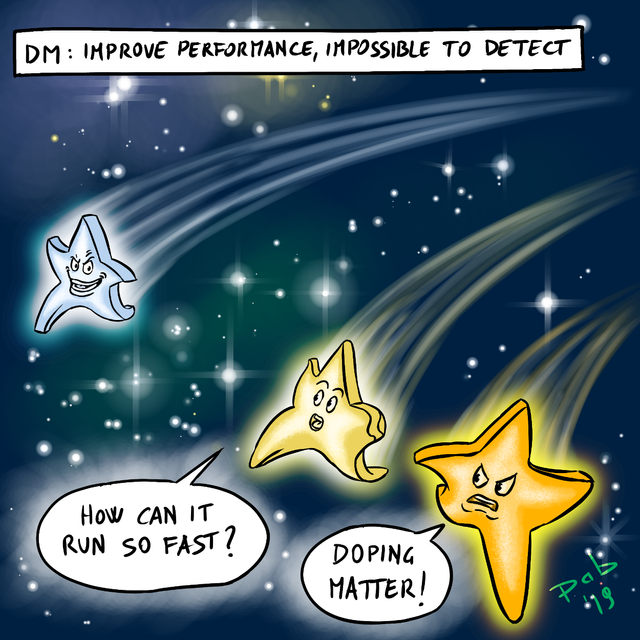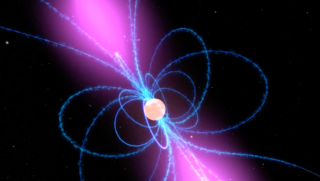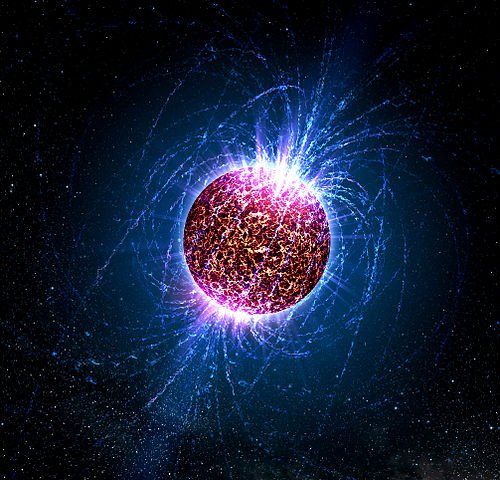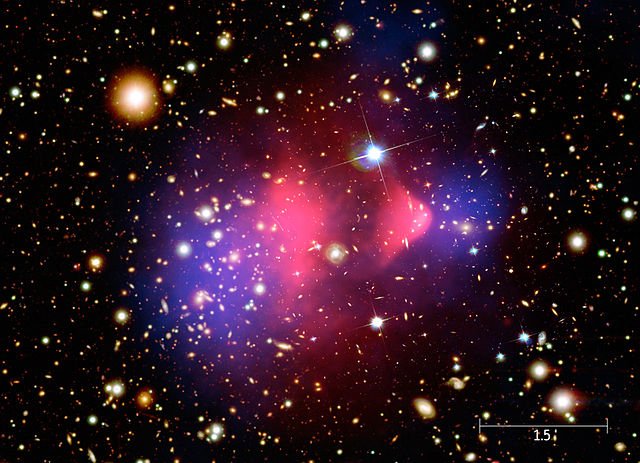Heating up neutron stars with dark matter
Summer time makes particle physics blogging slow… Anyways, here I am, after having read a recent article discussing the usage of neutron stars to detect dark matter. In some cases, dark matter can heat up neutron stars and hence provide an observable signature.

[image credits: @pab.ink]
The idea would however work solely for muonphilic dark matter, in which dark matter primarily interacts with normal matter through muons (and nothing else). I recall that a muon is one of the elementary particles of the Standard Model of particle physics, and can somehow be seen as a heavy instable cousin of the electron (in which it decays into).
Whilst this could sound a little bit ‘cooked’, there are anomalies detected by the CERN Large Hadron Collider (see for instance here) that could be resolved with particles exhibiting a specific connection to muons. Moreover, issues with the muon anomalous magnetic moment are longstanding, and could also be cured with new muonphilic particles.
This is exactly why our story is interesting: we may have a single theory featuring dark matter, an explanation for the LHC anomalies and the anomalous magnetic moment of the muon.
Neutron stars in a nutshell

[image credits: NASA ]
When a quite massive star dies (and by massive, I mean 10-30 times the mass of the sun), its core collapses by the action of gravity.
All the ‘fuel’ of the star has been burned and there is indeed nothing anymore that can prevent the gravitational collapse from happening.
This compression generates the implosion of the inner part of the star, that then rapidly collapses even more.
Consequently, the inside temperature rises and the electrons and protons initially constituting the star annihilate into neutrons.
However, at some point, the neutron degeneracy pressure comes into the game and stops the contraction. This degeneracy pressure is related to the Pauli exclusion principle inherent to quantum mechanics.
In very few words, two different neutrons cannot occupy the same state. As nature always aims to minimise the total energy of a given system, the first neutron will occupy the state with the lowest energy and the second one the next-to-lowest energetic one. However, within the core of the star, we have a lot of neutrons so that quite energetic states end up being occupied.

[image credits: Casey Reed (public domain)]
The left-over of the star hence resists further compression, as more and more energy is needed to pack more neutrons.
After a supernova explosion, the remnants of the star are mostly neutrons, packed in a sphere of 10-20 km of radius that roughly weighs three solar masses.
This is what is called a neutron star.
Neutron stars are however not only made of neutrons, as detailed for instance here. It also typically contains one muon for every 100 neutrons. This is the key property for the following.
Muonphilic dark matter
To make a long dark story short, dark matter is (indirectly) evidenced today by many observations.

[image credits: NASA (public domain)]
Initially, dark matter has been postulated to explain the velocity of the stars, when moving within galaxies.
Some mass (i.e. dark matter) was missing to be able to explain their motion with the sole help of Newtonian mechanics.
But this is not all.
The measurement of the properties of the cosmic microwave background (the fossil radiation left over from the Big Bang), as for instance done by the Planck collaboration, allows for a very good fit of the Standard Model of cosmology (that includes a dark matter component).
Moreover, in order for cosmological simulations to correctly reproduce the formation of the galaxies, dark matter is highly needed.
However, despite those strong hints, the true nature of dark matter remains elusive. This therefore offers a nice playground for theorists to design many dark matter models.
As mentioned in the introduction to this post, hints originating from different areas of particle physics suggest that muons can play a special role. Therefore, the scientific article that I discuss today introduced the idea of muonphilic dark matter.
In their model, the authors introduced a new fundamental interaction yielding to a viable (in the sense of agreeing with data) dark matter relic that mainly couples to muons.
Take-home: neutron stars as a window to muonphilic dark matter
Due to the rare amount of muons in the universe, muonphilic dark matter is predicted to be rather invisible to all experiments searching for it. However, neutron stars feature a large density of muons and could hence be the only places of the universe to look for muonphilic dark matter.
Typical neutron stars cotnain about of 1055 muons, which is more than enough to capture dark matter. This capture transfers heat from dark matter to the neutron star, so that the star temperature could go up by a few hundreds to a couple of thousands of degrees.
This subsequently leads to radiation that could be observed by several future telescope projects, like the James Webb Space Telescope.
In other words, muonphilic dark matter, if existing, will not stay elusive for long.
PS: This article has been formatted for the steemstem.io front-end. Please see here for a better reading.
SteemSTEM
SteemSTEM aims to make Steem a better place for Science, Technology, Engineering and Mathematics (STEM) and to build a science communication platform on Steem.
Make sure to follow SteemSTEM on steemstem.io, Steemit, Facebook, Twitter and Instagram to always be up-to-date on our latest news and ideas. Please also consider to support the project by supporting our witness (@stem.witness) or by delegating to @steemstem for a ROI of 65% of our curation rewards (quick delegation links: 50SP | 100SP | 500SP | 1000SP | 5000SP | 10000SP).
Gosh @lemouth, I don’t remember the last time I read something containing so many unfamiliar terminologies. I had to google what a muon is, but I prefer your description : “ the electron’s instable cousin”. Every family seems to have one of those. Even in the atomic world. 😌
So, is dark mater something that is yet to be proven? Did I get this right? And muons (and their dark matter??) pave the way towards it? 🙈
All right it’s time to get ready for lunch over here.
Have a great weekend :D
I have actually tried to make this post self-consistent, in the sense of defining each jargon term in simple words. Maybe not enough... :D
Assuming dark matter allows us to get a nice agreement between cosmological data and theory. However, we have not managed to directly observe dark matter, so that it is indeed not yet proven. Conversely, other theories exist and they have not been excluded (at the same time of not having been proven correct too).
Muonphilic dark matter is just one option that may explain why we have not observed dark matter yet and resolve several other current issues in particle physics.
I hope this clarifies! Do not hesitate to come back to me if you have more questions. I am happy you crossed the border and reads my posts ;)
PS: I think I will go with shorter posts in the future. Maybe this could attract more interest from non-physicists. I don't know.
Yes! It does clarify :) Thank you for taking the time to do so!
And yes, it was about time I crossed the borders and provided feedback to your work here. I've been afraid of sounding silly, but you have slowly put me at ease. So, I finally took the plunge! The friendly featured image, and the length of your writing definitely helped with this one. But, your encouragement over time was crucial. Finally, your kind, patient reply has definitely motivated me to come back for more :)
Thank you @lemouth :D
Ps: Shorter posts are a good call. I am also making an effort to do this as of late.
Happy painting to you guys.
Bye, bye for now.
I will always be happy to answer and give all necessary clarifications!
PS: the painting is going well: ceilings almost done, all white walls done, all "cream" walls done. Only the blue walls are left. With the two layers, we should be done by Tuesday ;)
Just loved how easy you made it even for a biologist like me to understand particle physics and cosmology. There are few questions that came to my mind though. I mean again they might sound very naive, but I will ask them anyway.
This came to my mind while watching a Netflix series. How is dark matter distributed in a galaxy? Is it more like homogenous throughout, at the periphery or it has its own local clusters like normal matter? Is there any hint through velocities of stars in the galaxy that can reveal the distribution?
I assume muonophilic dark matter as of now is a hypothesis. How did we come to this conclusion, that some dark matter may love muons but not other forms of normal matter. Or do we also have electronphilic, heavy quarkphilic dark matter too? What made muon so special?
Posted using Partiko Android
Thanks for this nice comment. I am really trying hard to make it easy to understand, but as I am biased, I am easily screwing it up (this already happened in the past on this very same platform) ;)
Dark matter is by far not homogeneously distributed. First, dark matter tends to be where normal matter is. The reason lies in galaxy formation: in order for the galaxies to be what they are today, dark matter seeds were needed in the early days of the universe so that gravity could act and make galaxies forming. Locally, it is assumed that there are dark matter halos around the galaxies, as evidenced by the galaxy rotation curves (otherwise, the stars lying far from the galactic center would rotate not as fast as observed). But the halo itself is not uniform and more on the clumpy side.
It is indeed a new idea. As dark matter has not been directly observed, physicists have to think how this is possible. And this is how new ideas like muonphilic dark matter pop up. This may be one good reason why dark matter has not been observed so far.
I have myself worked on topphilic dark matter (strong connection to heavy quarks), see for instance here. I do not remember having reads anything about electronphilic dark matter, but there are a few papers on that too, especially when dark photons are also involved (I should however read them to give you more insights).
I hope it clarifies. I have to leave now so that I can't answer more longly, but feel free to come back to me for more precisions!
I love the word 'muon'. I spent a few minutes looking up its origin and ran into antimuon. Then I read in wikipedia
And in your piece I read:
And then you state:
The unifying theme in these statements, and in your search for proof of dark matter, seems to be this: The order of nature, as the state of physics understands its laws, determines the parameters of your search. Right now, dark matter is theoretical. But muons are concrete. The concrete muons may provide a path to dark matter and therefore finally prove its existence. The thing that I respect is that no one is making a leap without proof, without a concrete path.
Thanks for giving us a glimpse into the mysteries of the universe. Must be exciting to be on this frontier.
You did it right. It is totally true muons exist (they may even be responsible... for life, through cosmic rays). On the other hand, we highly need dark matter to explain all cosmological observations (however, alternatives exist), but dark matter still evade detection (the alternatives have drawbacks, potentially more severe, too). Therefore, the idea here is to combine both: dark matter that only interacts with muons, which can consequently explain why it is not been observed yet.
🙂
I upvoted my own comment (above)--need a GPS to navigate the platform :))
You seem to really like yourself then :D
😅
Very nice read @lemouth :-)
Such masses are very hard to imagine. If we cut out a small piece (1 x 1 x 1 cm) from a Neutron Star of 20km radius, this would be roughly 1,780,573,758,736 kg for this 1cm³. I hope I didn't make a miscalculation, there are too many zeros in those numbers. That sounds crazy and impossible, but in reality, it's not even the most massive.
So the Muons will act as a "bridge"that will allow dark matter to interact with detectable matter besides the gravitational force?
Thanks for the reading and the questions! It is really appreciated! ;)
The reality is actually much more complicated than that. Neutron stars are by far not uniform. Whilst the density at the border of the star is 'only' of about 100 tons per cm3, it increases by a factor of 1 billion when one moves towards the center of the star. However, the truth is that whilst we have a good idea of what is going on with the first layers of the star, the central layer is a total unknown and a challenge for theoretical physics (we can see a neutron stars as made of an outer and inner curst, as well an outer and inner core; the inner core is a total mystery for us).
Exactly. Dark matter would have, on top of its usual gravitational interactions, an extra direct interaction with muons.
I hope it clarifies!
You*'re welcome :-)
Thank you very much for your explanations.
I think I need to read much deeper into Neutron Stars and particle physics, these are very exciting objects. I also hope to read more from you about it in short ;-)
For particle physics, I can recommend this that I wrote many months ago. It gives link to several introductory posts on particle physics.
For the neutron stars, I am by far not an expert, but this is a great start.
From there, we can of course continuing discussing (and feel free to question me).
Thank you very much @lemouth :-)
Very kind for picking out the links. I hope to update my knowledge in these regions. I also picked out some stuff, just need to find a quiet hour to get in it.
If I have further questions, I will come back to you :-)
I repeat: please don't hesitate :D
A lot more understandable than the thesis (or paper?) i still have open in a tab hahah, you do make it work ...
A question though (also : are neutron stars potential predecessors of black holes or do black holes only come from even more massive stars collapsing ?) but the question as i'm in interview mode for a second after reading this;
https://www.sciencedaily.com/releases/2019/08/190807190816.htm
on the matter of dark matter , any thoughts ? (if you have time ofcourse to read, its not very long) and ... cosmic inflation is NOT the planck era if i understand correctly (now), it pre - dates the planck moment which is actually already part of the big bang ... (please correct me if i'm wrong, all those terms used so casually can be quite confusing for the layman...)
You need much bigger stars to start with to get a black hole instead of a neutron star. So in other words, they are not predecessors of each other.
I don't have any thoughts on the paper you are referring too (that is available from here). It seems like a new idea about dark matter (that appeared at the very first moment of the universe history) that is very valid and will be testable in a few years. I however do not understand the pre-big-bang statement as the two examples of the introduction refer to cosmic inflation and dark matter freeze-in that occurs after the big bang... I will read it more closely after my return from vacation :)
Well, you're the expert sensei ... don't let it take up too much of your time, i bet you have like a stack of paper on your desk by the time you get back.
Every answer comes with tenfold questionmarks attached, right . I've always been a bit confused on expanding universe versus black holes drawing everything inward ... shouldn't they , in the end consume it all ?
i mean the more massive one gets as it gobbles up more matter/energy, the further it reaches so the more it can eat as a consequence. Would that be possible that in the end the universe would "breathe in" again , come all together into the biggest supermassive dense object , which in turn
(heh)
implodes on itself to create, what's that called
a singularity ? (the lingo isnt my forte) which leads to a big bang and the circle is round (pardon the philosophy its about 4am lol)
always a pleasure
I have at least a full stack of e-mails (only about 200 thanks to the vacation break) :D
For the rest of your question: there are different potential scenarios for the end of the universe. In other words, we do not know: The black holes will continue to attract everything, but in how long? Will the universe continue expanding as well? Who knows?
yes, that's my favourite answer in the world :) to know that we know nothing makes us the wisest of all greeks (at least to the oracle :) - hope you enjoyed the time off and have found re-newed vigor to tackle the myteries of the universe once more there !!!
It is always nice to be back at the office after a longish break (3 weeks in my case). I am still processing my e-mails and have not therefore done much new things today (more on the continuity of what was going on before my break).
Hm ... back to the dark arts of science, the fringe of exploring the universe for lack of global funding for Musk and the joy of experiencing entropy first hand in an office that's been waiting un-touched for three weeks.
Steemit's not the center of the universe (i think, although i also think some might disagree there) and without your work there there wouldnt be much to write here :)
Hope you enjoyed the leave and are able to tackle the multiverse in all its dimensions from all angles with renewed vigor now (i decided to split up to a separate account for talking so my "utilities" and dabll-ications dont mix up with my sometimes less popular opinion ..) good to have you back then !!!!
At least every time I ask something on google map, it shows that I am at the center of it ^^
But yes, I enjoyed my break! Back to the roots of doing something different ;)
I have read the paper and discuss it with colleagues earlier today. I think that the wording 'pre-big-bang' has just been used to get a buzz. Cosmic inflation is actually right after the big bang and not before it. At least to my knowledge on how it is usually used.
I see, thanks for the clarification. All a big mystery to me, a bit like wizards of old wielding magic but you probably won't see it that way although complex mathematics might as well be spellcraft to those who ain't versed in it. I have read the craziest theories, among others one were , as the concept of time starts with the big bang (there is no framework before that) it would be (in theory) possible that half of everything was shot backwards in time from that moment but on all other accounts i have only read that time points forward only under any circumstance. Even once an article on how some supreme genius had succeeded (probably also in theory and math) to somehow propell data/information to the future but that it wouldn't be possible to do the same backwards either, which in essence came down to time travel might be possible but not to the past
... in theory :) 5am i should probably give it a rest , thanks for the reply
This is correct. Strictly speaking, the "before big bang" is undefined. Note that there are as well alternative cosmologies without a big bang.
Educational blog like it.
Congratulations @lemouth! You have completed the following achievement on the Steem blockchain and have been rewarded with new badge(s) :
You can view your badges on your Steem Board and compare to others on the Steem Ranking
If you no longer want to receive notifications, reply to this comment with the word
STOPVote for @Steemitboard as a witness to get one more award and increased upvotes!